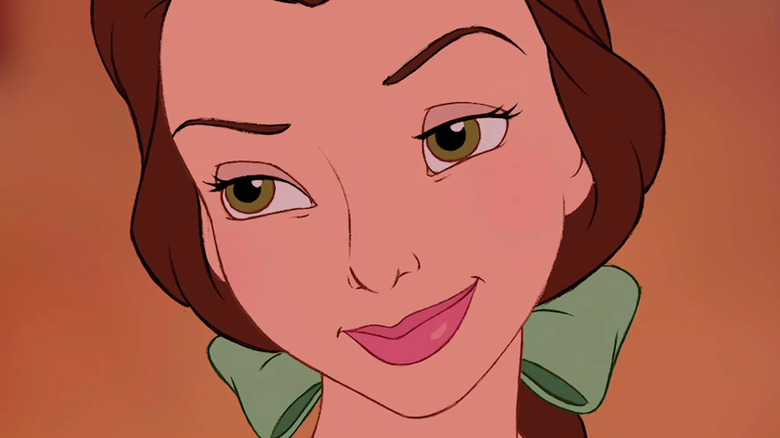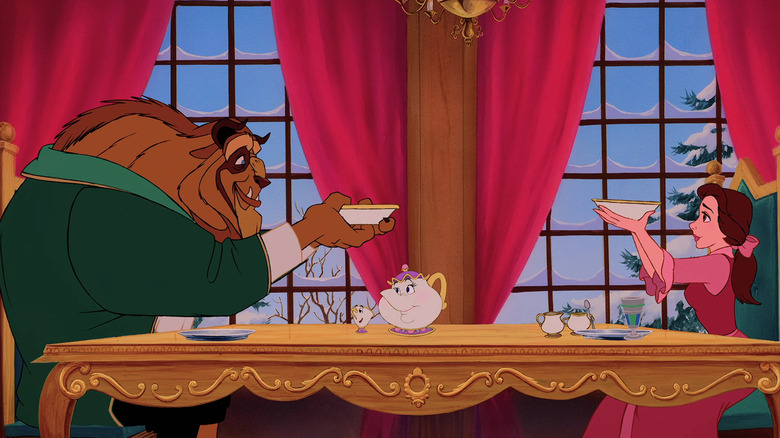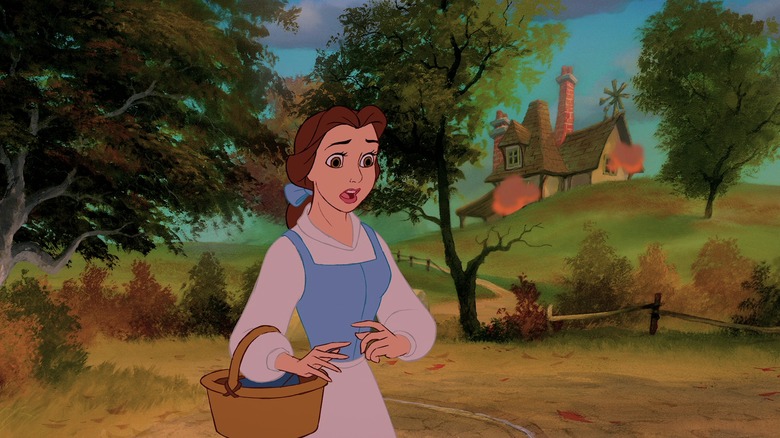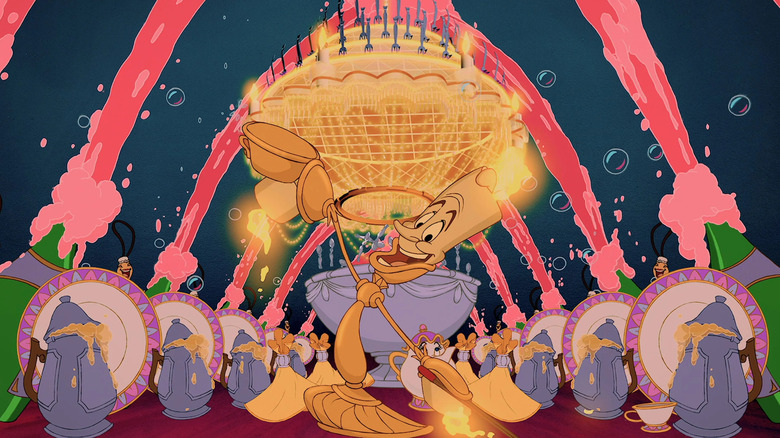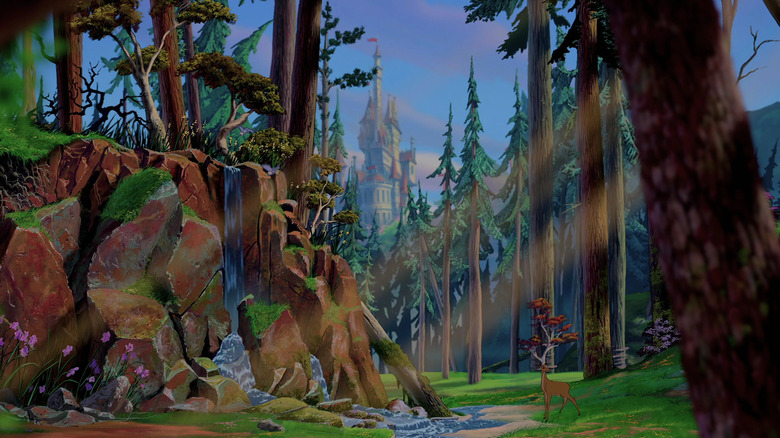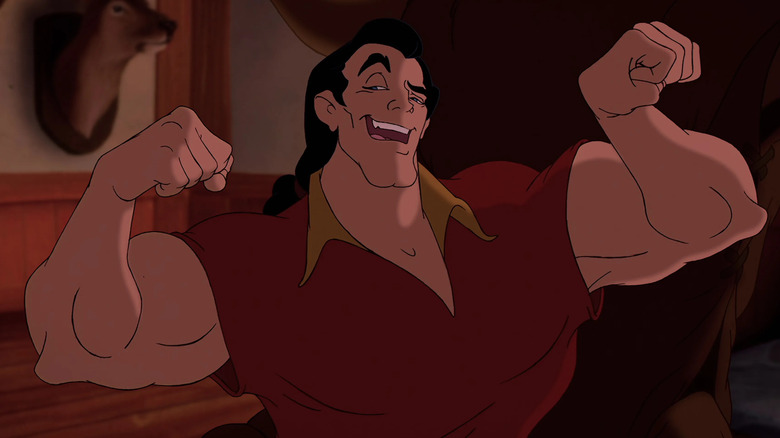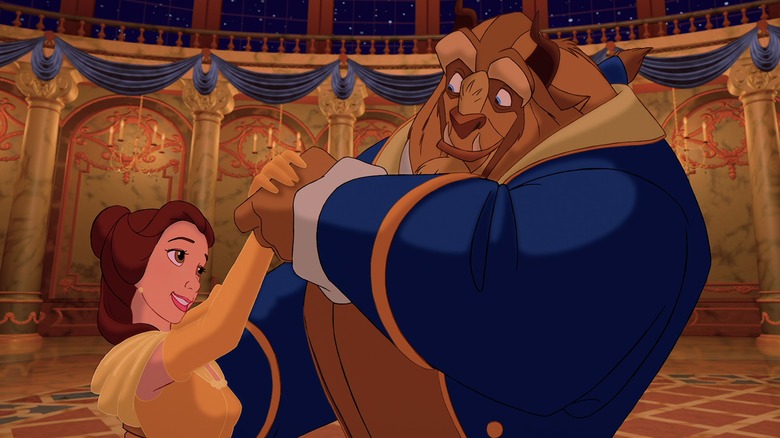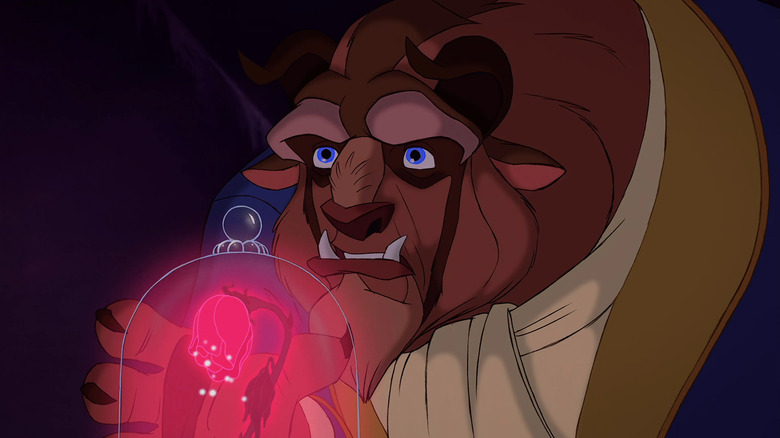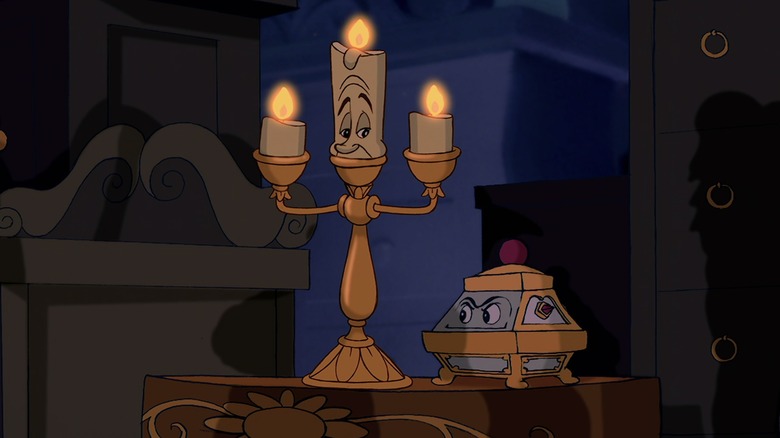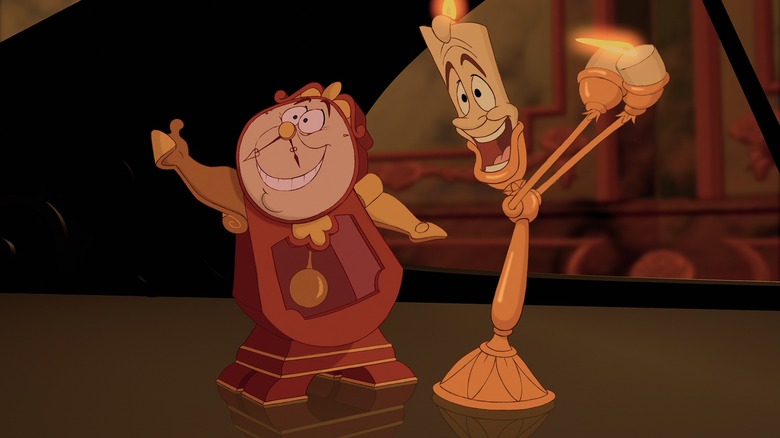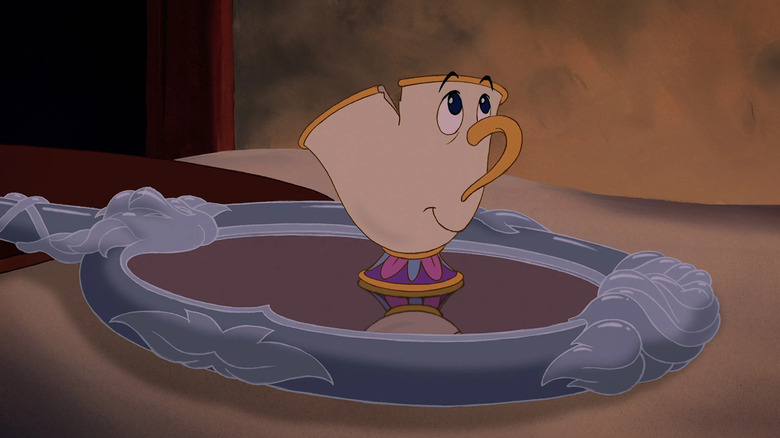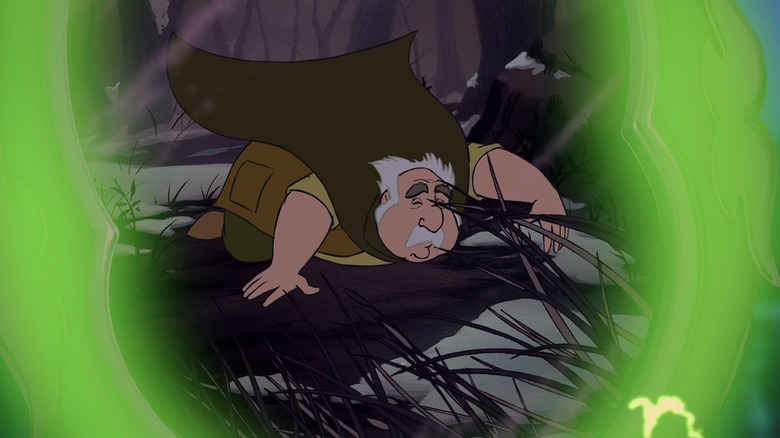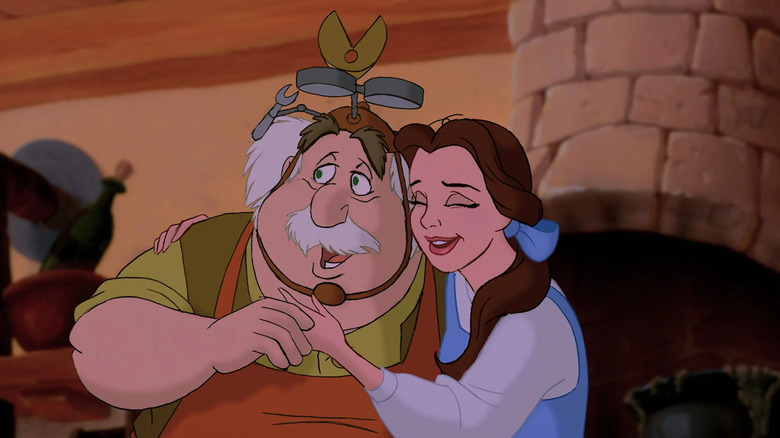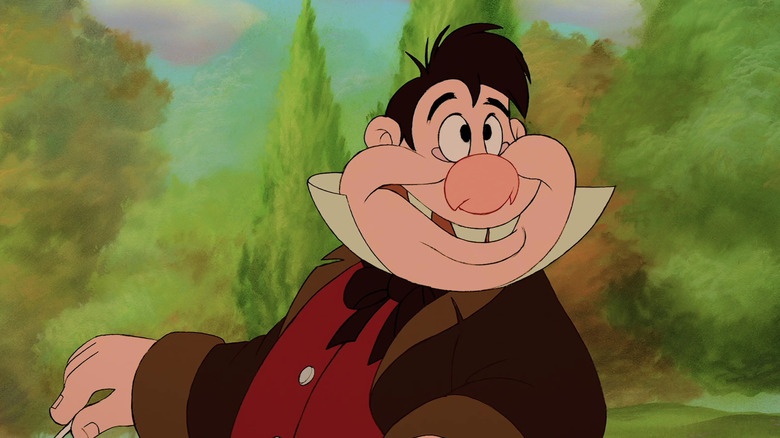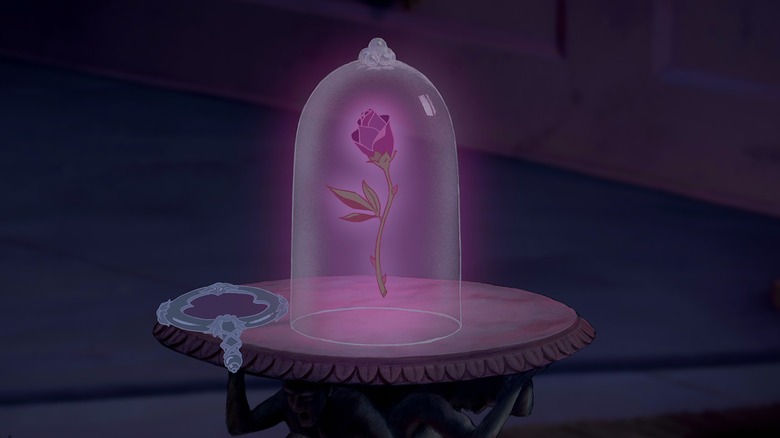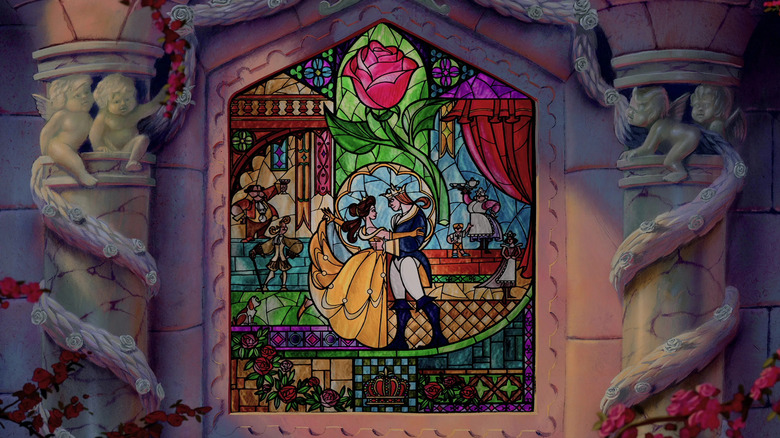The Untold Truth Of Disney's Beauty And The Beast (1991)
The tale as old as time has some untold history to share. "Beauty and the Beast" enchanted audiences around the world when it first debuted in 1991. Walt Disney Animation Studios created a fairy tale for all ages as it told the story of a man who became a beast, and a girl dreaming of adventure who'd grow to love him.
In retrospect, "Beauty and the Beast" was arguably the critical peak of the era that came to be known as the Disney Renaissance — a beloved period that also brought us "The Little Mermaid," "Aladdin," and "The Lion King." Disney seemed to have the Midas touch, but as we'll explore below, success wasn't guaranteed.
So, it is with deepest pride and greatest pleasure that we welcome you to this feature article. And now we invite you to relax and pull up a chair as Looper proudly presents the untold truth of Disney's 1991 animated classic, "Beauty and the Beast."
Walt Disney tried to make the movie twice
Walt Disney Animation Studios released "Beauty and the Beast" in 1991, but the movie's origins with Disney go back over 50 years prior. The 2016 Blu-ray bonus feature "#1074: Walt, Fairy Tales, and 'Beauty and the Beast'" reveals Walt Disney took a trip to Europe in 1935 and bought a whopping 335 books. This collection became the foundation that would inspire early Disney animated features.
One of these books was "The Sleeping Beauty and Other Fairy Tales from the Old French" by Charles Perrault. Among the "Other Fairy Tales" in the volume was "Beauty and the Beast," which the animation department selected for a future project with the production number "1074." The development didn't get very far. The only artwork known to exist from this attempt is an illustration showing "Beauty" caring for "the Beast" and his wounds. Disney again tried to produce "Beauty and the Beast" in the '50s as part of his Sunday night television program, "Disneyland," which often featured hour-long retellings (both animated and live-action) of classic stories. But this too never came to fruition.
Veteran animators from this period couldn't figure out how to add excitement to the story. In the original text, the Beast character simply asks the girl to marry him each night at dinner until one day she says yes. The new generation thought they could overcome this obstacle and decided to give the tale another go — and we're so glad they did.
Beauty and the Beast wasn't a musical at first
Animators in the '80s initially developed the movie as a non-musical. Filmmakers who worked on this rough draft share a bit about it in the documentaries "Howard" and "Waking Sleeping Beauty." Reportedly stuffy and somewhat boring, some animators referred to this version of the movie as "animated 'Masterpiece Theater.'"
Over the course of six months, the first 20 minutes of the movie were written and storyboarded. Those first 20 minutes, which can be viewed as part of the bonus features on the film's 2010 Blu-ray and subsequent digital release, are ... rough. In this version, Belle's aunt constantly fusses at her to marry Gaston, and Maurice's visit to the castle is a series of dull interactions with faceless enchanted objects.
A screening for Disney executives ended with strict instructions to throw the whole thing out and start over. Soon thereafter, production moved to Disney's homebase in California, when Kirk Wise and Gary Trousdale were assigned as new directors on the project (the duo would later direct "The Hunchback of Notre Dame" and "Atlantis: The Lost Empire"). It was also at this time that Alan Menken and Howard Ashman, fresh from their hit success on "The Little Mermaid," came aboard to make the film a musical.
Be Our Guest was almost sung to Maurice
Lumiere's showstopping "Be Our Guest" is one of the most memorable songs in "Beauty and the Beast." The bouncy tune shows the enchanted objects welcoming Belle to her new home, trying to ease the sorrow of being separated from her father by showing her they're excited to serve her. But the "guest" they welcome wasn't always Belle.
When the song was first written, the enchanted objects sang "Be Our Guest" to Belle's father, Maurice. In the film, Maurice stumbles upon the castle after getting lost in the woods. Later Belle comes to find him and takes his place as the Beast's prisoner. Initially, "Be Our Guest" would have come in the moments after Maurice arrives at the castle, but before Belle gets there.
While it might seem nonsensical, there was logic behind the choice. In the movie's 2002 audio commentary, director Gary Trousdale shares, "The idea was that these poor little objects have been stranded and alone with nothing to do for so long, that the first person they saw, they were so happy to serve. That was Maurice."
Later, an animator suggested that maybe they were singing to the wrong person. Since Maurice is only there momentarily, and Belle will be distraught later in the story anyway, shouldn't they be welcoming Belle instead? That made much more sense. "Be Our Guest" was moved to later in the movie, and re-animated with Belle instead of Maurice.
The movie recycles animated moments from Disney' past
While it's true that sometimes animators place references to other movies in their work as fun tributes, other times animation is simply recycled for the sake of time. This was the case with two sequences in "Beauty and the Beast" that reuse animation from older Disney movies, which producer Don Hahn discloses in the film's audio commentary.
The very first shot in "Beauty and the Beast" is a beautiful push-in of the castle from deep within the forest, which at this point in the story is thriving with life. Among the wildlife visible in the frame is a deer eating some grass, who perks its head up and looks off-camera as if it heard something in the trees. The deer is actually Bambi's mom, superimposed from the 1942 Disney classic. The context of the original animation is the animal hearing hunters in the woods, immediately pausing her meal, and urging her son to make a run for it. We all know what happens after that. Way to start the movie on a downer, "Beauty and the Beast."
In contrast, the final shot in the movie also utilizes recycled animation. With the spell broken and true love having prevailed, Belle and Beast dance together in the ballroom and the camera pans out. This animation of the couple dancing is a retrace of Aurora and Phillip dancing at the end of 1959's "Sleeping Beauty." Once upon a dream, indeed.
An all-star roster of animators drew the movie by hand
When glancing through the credits of "Beauty and the Beast," some unsung heroes stand out as experts in their field.
Glen Keane was the supervising animator for Beast while Mark Henn animated Belle. The two were no stranger to protagonists, having shared supervising duties animating Ariel in "The Little Mermaid." After "Beauty and the Beast," Keane continued the tradition by animating the lead characters in "Aladdin," "Pocahontas," and "Tarzan." Keane later directed the Oscar-winning animated short "Dear Basketball," which starred the late Kobe Bryant. Henn would go on to animate Jasmine in "Aladdin," the title character in "Mulan," and many others. He still works for Disney at the time of this writing, recently working on "Encanto."
The supervising animator of Gaston, Andreas Deja, would earn a reputation for animating villains. Deja later animated Jafar in "Aladdin" and Scar in "The Lion King."
The story department for "Beauty and the Beast" was led by two talented artists who would one day direct their own films. Roger Allers later co-directed "The Lion King," while Brenda Chapman would go on to direct "The Prince of Egypt" for DreamWorks and "Brave" at Pixar.
One name might lead to a double-take for those who know him from elsewhere. The supervising animator for the wardrobe was none other than Tony Anselmo, who in addition to being a former Disney animator, has also been the voice of Donald Duck since 1986.
The film leveraged advances in animation
Disney created "Beauty and the Beast" during an exciting time in the history of animation, leading to the film showcasing the best of both worlds: the artistry of hand-drawn animation, accompanied by computerized special effects used sparingly and subtly. This melding of technology is elaborated upon in the 2010 documentary "Beyond Beauty: The Untold Stories Behind the Making of Beauty and the Beast."
When heads of story Brenda Chapman and Roger Allers storyboarded the iconic ballroom sequence, during which Belle and Beast dance while Mrs. Potts sings the film's title song, they thought the sequence could be elevated by new tech. By making the ballroom a computer environment, the "camera" would be able to swoop around Belle and Beast as they dance in a graceful, powerful way that wouldn't be possible if the room was a 2D space. Their pitch was greenlit, and the scene is one of the most moving moments in animation — no pun intended — as a result.
Supervising animator David Pruiksma shares that it wouldn't have been possible to bring Mrs. Potts to life the way he did without using CAPS (Computer-Animated Production System, which "Beauty and the Beast" was the second film to utilize after "The Rescuers Down Under"). After Pruiksma animated his scenes, crew members added highlights and shadows to Mrs. Potts in CAPS to bring dimension and depth to what might have otherwise been just a flat, hopping face.
An unexpected TV personality auditioned for Beast
Sometimes a studio might have a specific person in mind for the role of a character, and simply make an offer to that actor. Other times, the studio might issue a traditional casting call and actually hold auditions. The latter was the case for the important role of the Beast.
The part ultimately went to Robby Benson, but producer Don Hahn reveals in the movie's audio commentary that among the many people who auditioned for the voice role of the Beast was ... Regis Philbin. Yes, that Regis Philbin, the late host of the daytime talk show "Live with Regis and Kathie Lee," which would later become "Live with Regis and Kelly."
Philbin has such a distinctive voice that it's fun to imagine what he might have brought to the Beast, or how his voice would have influenced the personality of the character, if at all. Given this knowledge, it's also awkward to remember Philbin annually hosted Walt Disney World's Christmas Day broadcast on ABC, which almost always included Beast among its parade characters and in 1993 was even co-hosted by Robby Benson. Philbin had to emcee with the guy famous for the part he didn't get. What a good sport.
Over a decade later, Philbin would eventually get to voice a Disney character: himself. He voiced an animated version of his likeness, which appeared in 2004 on Disney Channel's "Lilo and Stitch: The Series." (You can find the episode, titled "Drowsy," on Disney+.)
Look closely for a deleted character
In an early draft of the script, Belle befriends a music box character in the castle, according to directors Kirk Wise and Gary Trousdale in the movie's audio commentary. The character is supposed to provide some comic relief, be a kind companion to Belle when she needs a friend, and win audiences over with a cutesy attitude.
However, as recording sessions began and actor Bradley Michael Pierce started voiceover work for Chip the teacup, the filmmakers changed course. They loved Pierce's performance as Chip so much that they started giving Chip more and more lines, and before they knew it, Chip had basically filled the same role in the script that the music box was written to have.
They removed the music box as a character in the movie, but if you look closely as the villagers enter the castle just before the final battle is about to take place, you can spot the long-lost character waiting motionless next to Lumiere. It may not have any dialogue, but it still gets in on the action.
Another bit of removed "Beauty and the Beast" history? As Gaston stalks Beast on the castle balcony toward the end of the movie, he threatens, "Belle is mine!" The original line — which made it all the way into a recording — was "Time to die!" Even for Gaston, that's dark. The line was re-recorded with new dialogue, though Gaston's mouth still matches the old line.
The movie made Oscars history
"Beauty and the Beast" became a phenomenon upon its debut in 1991. Its incredible music and dynamic characters engaged with audiences of all ages. It transcended demographics so much that "Beauty and the Beast" became the first animated film ever to be nominated for Best Picture at the Academy Awards.
The film gained attention in other categories, too. It was also nominated for Best Sound, Best Score (which it won), and Best Song (which the title song won against two other nominations from the movie, "Belle" and "Be Our Guest").
It would ultimately take 18 years for another animated film to join "Beauty and the Beast" in the Best Picture nominees' club. In 2009, Pixar's "Up" was nominated for the award, and the very next year, so was Pixar's "Toy Story 3." The honor of being nominated has not been bestowed to another animated movie since.
Like the Jonas Brothers? Thank Beauty and the Beast
In 1994, "Beauty and the Beast" was the first Disney film to make the leap to Broadway. (It was later followed by "The Lion King," "Tarzan," "Mary Poppins," "The Little Mermaid," "Newsies," "Aladdin," and "Frozen.") A Great White Way staple through 2007, its 13-year run included famous and yet-to-be-famous actors among its cast, detailed in the 2010 Blu-ray bonus feature "Broadway Beginnings." Susan Egan, Toni Braxton, Christy Carlson Romano, and Anneliese van der Pol each played Belle at different times in the show's New York tenure. Gaston was performed by Donny Osmond for a while.
Chip was at one point played by Nick Jonas, who realized something important about himself thanks to the role. Every year around the holiday season, Broadway performers produce an album called "Carols for a Cure" to benefit Broadway Cares/Equity Fights AIDS. Jonas was invited to participate in the CD's 2002 volume. He asked if he could write an original song, and the experience that followed was his first time writing and recording for a produced album. Jonas would, of course, go on to form a rock band with his brothers, Kevin and Joe. "'Beauty and the Beast' played a big part in me discovering that music recording and being an artist was something that I wanted to do," Nick says in "Broadway Beginnings." You might call "Beauty and the Beast" the place where "happiness begins."
Just how long was Maurice lost in the woods?
One song that Alan Menken and the late Howard Ashman wrote, "Human Again," showed the enchanted objects dreaming of the day when the spell would be broken. In the film's audio commentary, Menken elaborates on the song's troubled creative journey.
"Human Again" wasn't destined for the final cut of the movie in 1991. For starters, it was 11 minutes long. Menken and Ashman submitted a shorter revision, but even so, the filmmakers faced a storytelling challenge: seasons pass over the course of the song, and at that point in the film, Maurice had already left home to rescue Belle. This would have meant poor Maurice was lost in the woods for months on end (animators made joke sketches of him winding up at places like the Egyptian pyramids and the Eiffel Tower).
When the Broadway adaptation of "Beauty and the Beast" found a way to include "Human Again" in the story, the original animators were inspired to go back and rework the song to fit within the movie. They created a completely new animated sequence and inserted it into a Special Edition of the movie, which debuted in IMAX theaters in 2002.
Maurice's plight might have been solved in 1991, but the logic was seemingly thrown out the window once more for the 1997 direct-to-video film, "Beauty and the Beast: The Enchanted Christmas," which also showed a passing of seasons taking place within the timeline of the first movie.
Where's Belle's mom?
One character we never see in "Beauty and the Beast" is Belle's mother. While we might assume she passed away, she's never mentioned. In the 2017 live-action remake, we discover that Belle's mother died from the bubonic plague when Belle was young, but nothing like that is addressed in the animated film.
While even her existence might be absent from the animated film, Disney acknowledges Belle's mom in an unexpected place. Guests at the Magic Kingdom in Florida's Walt Disney World can participate in "Enchanted Tales with Belle," an interactive experience in which families visit the Beast's castle and help Belle tell the story of "Beauty and the Beast." The attraction, which opened in 2012, involves time travel. It begins after the movie and then transports guests back to the moment right before Belle dashes off to go dance with the Beast in the famous ballroom scene.
The line for entrance to "Enchanted Tales with Belle" starts in Maurice's cottage. Hanging prominently on the wall is a portrait of a woman we can only assume is Maurice's wife, with a young Belle in her lap, probably about five years old. This lets us know that Belle's mom was present for at least part of Belle's life, and she may have fond memories of their relationship. Another noteworthy part of this attraction? It features an insanely cool special effect in which a small magic mirror transforms into a passageway that guests enter to access the castle.
Le Fou is the secret hero of the movie
If you think Le Fou is just a jokester sidekick, you'd be wrong. In 2020, EPCOT at Walt Disney World opened its "Beauty and the Beast Sing-Along," a 15-minute film played exclusively at the park. The experience is mostly songs from the movie accompanied by onscreen lyrics that guests are encouraged to sing along with. Angela Lansbury narrates, wonderfully reprising her role as Mrs. Potts nearly three decades after first voicing the character.
In between the songs are new scenes of animation that reveal Le Fou actually had a much bigger role in the story than the original film implied. As Lansbury tells us, Le Fou is actually the "surprise hero of our story, the matchmaker who worked behind the scenes to help our lovers fall in love."
Did you ever see "The Lion King 1½", told from the point of view of supporting characters Timon and Pumbaa? Think of that, but for "Beauty and the Beast." It turns out that Le Fou secretly orchestrated many of the well-known scenes from the movie. The directional signs Maurice follows in the woods? Le Fou wrote them. The enchanted objects preparing a feast for Belle prior to singing "Be Our Guest"? That was Le Fou's idea. He even played the violin in broad daylight in the ballroom scene, but Belle seemingly was so locked on Beast's eyes that she didn't notice. Are we to assume a theme park film is canon? You can decide for yourself.
Olivia Rodrigo brought perspective to an unheard voice in the story
Each season on the hit Disney+ show "High School Musical: The Musical: The Series," the kids of East High put on their own, well, high school musical. In 2021, Season 2 of the show involved the students working hard to bring their own adaptation of "Beauty and the Beast" to the stage.
Over the course of the season, "HSMTMTS" cast members cover favorite "Beauty and the Beast" tunes from both the animated movie and the Broadway musical. They also add a new song, and even a new character, into the mix. Nini, played by Olivia Rodrigo, is cast in the show as a sentient version of the Beast's enchanted rose. While the rose still can't move from within its case inside the West Wing, the rose in this version can express its feelings to the audience as it withers away and watches the Beast grow more lonely over the years. In "The Rose Song," Rodrigo, as the rose, sings about feeling trapped in a way that parallels Nini's own situation in the series.
Beauty and the Beast is dedicated to a creative genius
Howard Ashman was the lyricist and executive producer of "Beauty and the Beast." He tragically passed away from HIV/AIDS while the movie was in production. The documentary "Howard" details how the first public audiences experienced "Beauty and the Beast" in the last days of Ashman's life.
Filmmakers attended a test screening in New York City, which despite only showing a work-in-progress version of the film made up of storyboards and unfinished animation, was met with thunderous applause and a standing ovation. The crew immediately visited the nearby hospital where Ashman was being cared for and shared with him that it seemed like the movie would be a hit. "Who would've known?" one of them asked Ashman. "I would," he replied, wearing a "Beauty and the Beast" sweatshirt. That was the last time the filmmakers saw him.
The end credits of "Beauty and the Beast" conclude with a dedication to Ashman: "To our friend, Howard, who gave a mermaid her voice and a beast his soul, we will be forever grateful. Howard Ashman, 1950-1991."
